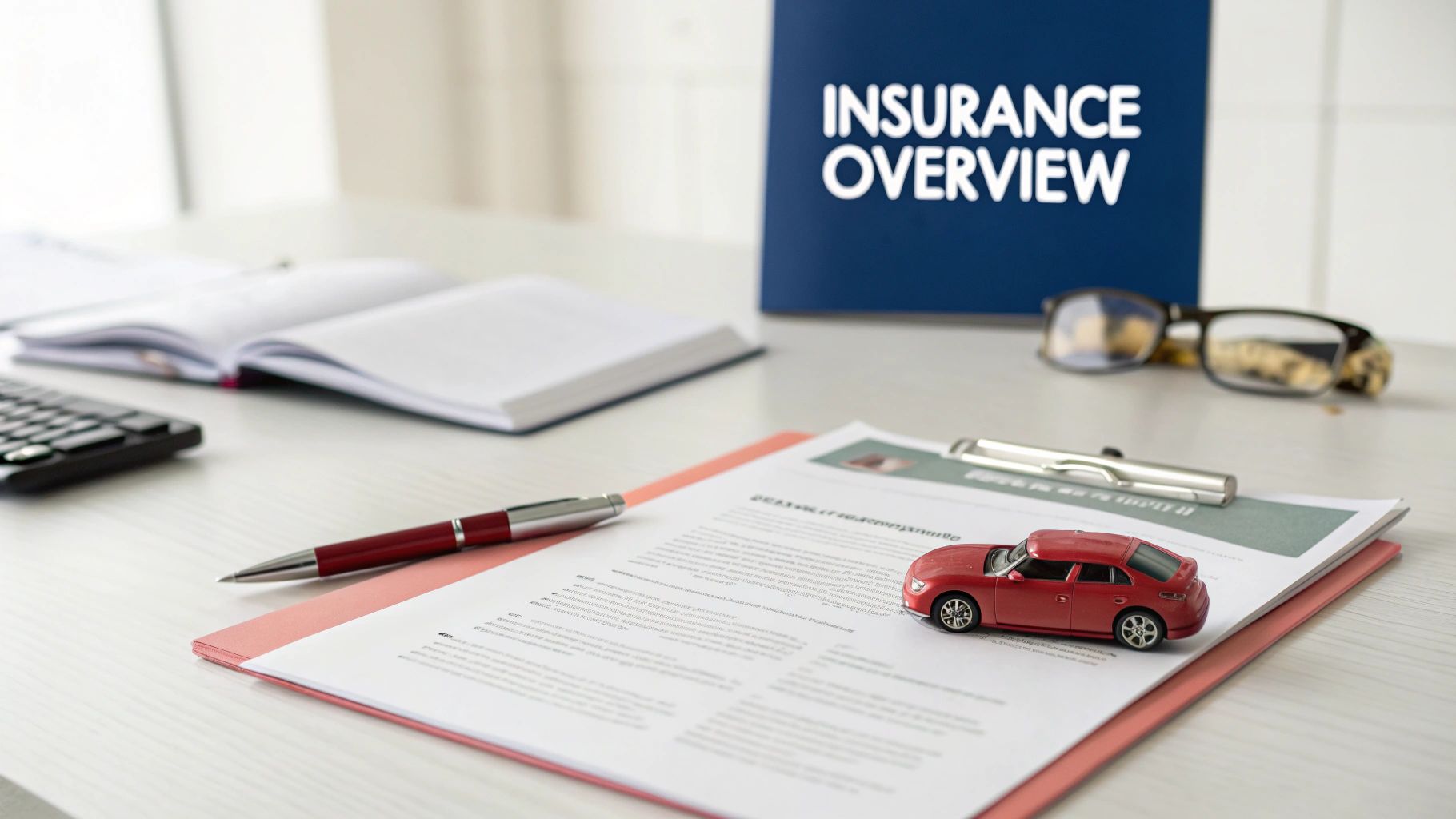Understanding Average Car Insurance Claim Amounts

Understanding the average cost of a car insurance claim is a valuable tool when assessing your current coverage and anticipating future needs. This involves considering several factors that can influence these averages. With this knowledge, you can make more informed decisions about your insurance policy and overall financial planning. Let's delve into what defines an average claim and how these figures are calculated.
Deconstructing the "Average" Car Insurance Claim
The phrase "average car insurance claim" can be deceptive. It isn't a fixed number but rather a range affected by various elements. A minor fender bender, for example, will result in a much lower claim amount than one involving significant injuries or a totaled car. Therefore, understanding the different types of claims is essential.
The frequency of claims also has a substantial impact. How often certain types of claims are filed varies considerably. Collision claims are the most frequent, occurring at a rate of 5.8 claims per 100 years of insured vehicle coverage. This underscores the importance of collision coverage in any car insurance policy. Property damage claims are less frequent, at 3.7 claims per 100 years.
Comprehensive claims follow at 2.8 per 100 years, while bodily injury claims are significantly less common, at 0.95 per 100 years. These statistics offer valuable insights into the inherent risks of driving and the importance of comprehensive coverage. You can find more detailed statistics from resources like Worth Insurance.
Finally, your location significantly influences average claim costs. States with higher accident rates or more expensive repair costs will naturally experience higher average claims. This means national averages may not accurately reflect the situation in your area.
To better understand the breakdown of average claim amounts, let's look at the following table:
Average Car Insurance Claim Amounts by Type
This table breaks down the typical payout amounts for different categories of car insurance claims.
| Claim Type | Average Claim Amount | Frequency Rate (per 100 years) | Common Causes |
|---|---|---|---|
| Collision | $4,500 | 5.8 | Collisions with other vehicles or objects |
| Property Damage | $3,800 | 3.7 | Damage to another person's property |
| Comprehensive | $1,700 | 2.8 | Theft, vandalism, weather-related damage |
| Bodily Injury | $16,500 | 0.95 | Injuries sustained in an accident |
This table provides a general overview, and actual amounts can vary depending on individual circumstances and location. It's crucial to remember that these are averages, and your specific situation might differ.
Factors Influencing Average Claim Amounts
Several key factors influence the final amount of a car insurance claim. The severity of the accident is a primary factor. Greater damage usually leads to higher repair costs and potentially more extensive medical bills, resulting in a larger claim. The type of vehicle is also a consideration. Luxury cars and newer models often incur higher repair costs compared to older, more common vehicles.
Your insurance coverage level directly impacts how much your insurer will pay. Higher coverage limits offer greater financial protection but typically come with higher premiums. Understanding your policy limits is essential for managing expectations about potential payouts. Finally, regional cost differences in labor rates and parts contribute to variations in average claim amounts. For example, repairs in a major city might be significantly more expensive than in a rural area.
Key Factors That Shape Your Claim Settlement

Several factors beyond the accident itself can significantly influence your car insurance claim settlement. Understanding these variables can help you better prepare and potentially maximize your claim. These elements range from your personal driving record to the specifics of your vehicle and insurance policy.
Personal Factors and Their Influence
Your driving history plays a crucial role in the claim settlement process. A clean record demonstrates responsible driving habits, which can strengthen your position. Conversely, a history of accidents or traffic violations could lead to a less favorable outcome.
Your age and location can also be factors. Statistically, younger and older drivers are sometimes associated with higher risk. Similarly, areas with higher accident rates or increased repair costs often experience larger average claims. Read also: The Surprising Impact of Your Credit Score on Car Insurance Rates.
Vehicle-Specific Elements
The make and model of your vehicle directly impact the cost of repairs. Luxury or high-performance cars generally involve more expensive parts and specialized labor, potentially leading to higher settlements.
The age and condition of your car are also considered. Older vehicles with pre-existing damage might receive lower settlements due to depreciation. A well-maintained vehicle, especially one equipped with modern safety features, could positively influence the outcome.
Policy Choices and Claim Outcomes
Your chosen coverage type significantly affects your potential settlement. Liability-only coverage pays for damages to the other party involved, but not your own vehicle. Collision coverage, however, covers your vehicle regardless of fault. Comprehensive coverage extends protection to non-collision incidents, such as theft or weather-related damage.
Your deductible—the amount you pay out-of-pocket before your insurance kicks in—also influences the final settlement amount. A higher deductible lowers your premium but means you'll pay more upfront when filing a claim.
The Broader Claims Landscape
The overall insurance claims industry also plays a role in individual settlements. The sector is experiencing significant growth. The global insurance claims services market is projected to reach $210.11 billion by 2025, increasing from $184.93 billion in 2024, and is forecast to reach $345.97 billion by 2029. This growth is driven by factors such as rising accident rates, increasing customer demand for better service, and ongoing technological advancements. You can find more detailed statistics here. This expanding demand for efficient claims processing underscores the importance of understanding all the factors that can influence your settlement, ensuring a smoother and potentially more beneficial experience.
Navigating the Claims Process Like a Pro

The aftermath of a car accident can be a confusing and stressful time. Understanding the claims process is essential for a smoother, less frustrating experience. Knowing how to navigate this process effectively can significantly influence the outcome of your car insurance claim. This guide provides a step-by-step overview to help you manage your claim with confidence.
Understanding First-Party vs. Third-Party Claims
One of the first steps is understanding the difference between first-party and third-party claims. A first-party claim is filed with your own insurance company. This covers damages to your vehicle or any injuries you sustained, regardless of who was at fault. This is where coverage types like collision and comprehensive come into play.
On the other hand, a third-party claim is filed with the other driver's insurance company if they were responsible for the accident. This involves demonstrating the other driver’s liability, which can sometimes be challenging. For more information about choosing the right car insurance policy, check out this helpful resource: Navigating the Car Insurance Maze: Tips for Comparing Policies. Understanding the rules for injured workers can also be helpful in specific regions.
Documenting the Accident Scene
After an accident, thorough documentation is vital. Take photos of the damage to all vehicles involved, including the surrounding area. Also, photograph any visible injuries. Be sure to collect contact information from the other driver and any witnesses. A detailed police report can significantly strengthen your claim.
Communicating with Insurance Adjusters
Clear communication with the insurance adjuster is key throughout the process. Clearly and concisely explain the accident and the resulting damages. Provide all requested documentation promptly. It’s highly recommended to keep records of all communication, noting dates, times, and the names of everyone you speak with.
Realistic Timelines for Different Claim Scenarios
The time it takes to settle a claim varies depending on the complexity of the accident. Minor accidents with clear liability may be resolved within a few weeks. However, claims involving serious injuries or disputes about who was at fault can take significantly longer, sometimes months.
Handling Roadblocks and Disputes
Disputes or delays can occur during the claims process. If you disagree with the insurance company's assessment of fault or the proposed settlement, don’t hesitate to negotiate. Providing supporting evidence or obtaining an independent appraisal of the damages can reinforce your position.
To help you navigate the process, the following table provides a general overview and checklist for managing your claim:
Car Insurance Claim Timeline & Checklist
| Stage | Timeframe | Required Actions | Tips for Success |
|---|---|---|---|
| Reporting the Accident | Immediately | Contact your insurance company and the police. | Gather all necessary information at the scene, including driver and witness information. |
| Investigation | A few days to several weeks | The insurance company investigates the accident and assesses damages. | Cooperate fully with the investigation and provide all requested documentation. |
| Settlement Offer | A few weeks to several months | The insurance company makes a settlement offer. | Review the offer carefully and negotiate if you disagree. |
| Claim Resolution | Varies | The claim is settled, and you receive payment. | Keep records of all communication and transactions. |
Understanding these steps and potential challenges can empower you to navigate the car insurance claim process effectively and work towards a fair resolution.
Maximizing Your Average Car Insurance Claim Payout

Filing a car insurance claim can be a daunting process. Understanding how to maximize your average claim payout, however, can significantly impact your financial recovery. This requires a strategic approach, going beyond simply filing paperwork. It involves meticulous documentation, clear communication, and effective negotiation.
Documenting the Damage: The Foundation of Your Claim
Comprehensive documentation is the bedrock of any successful claim. Think of your claim as a puzzle: every piece of evidence contributes to the complete picture. This begins at the accident scene itself. Take clear photos and videos of all vehicle damage. Close-ups of scratches, dents, and broken parts are essential.
Don't forget to document the surrounding area, as this can help illustrate contributing factors, such as road conditions. Gathering all necessary contact information is equally important. This includes the other driver's insurance details, witness statements, and the police report number.
A detailed police report offers an official record of the accident, often proving crucial in supporting your claim. Thorough documentation immediately after the accident prevents discrepancies later and reinforces the accuracy of your claim.
Communicating Effectively With Insurance Adjusters
After gathering your evidence, presenting your case to the insurance adjuster is the next critical step. Clear and effective communication is paramount. Be concise, factual, and avoid speculative or emotional language when describing the accident.
Focus on the documented evidence, referencing the photos and videos you've taken. For example, when detailing the damage to your car, directly refer to the visual evidence you've collected. This provides concrete support for your claim and enhances its credibility.
Maintaining meticulous organization is equally important. Keep copies of everything submitted to the insurance company. This includes photos, videos, witness statements, medical records, and repair estimates. Organized documentation streamlines the claims process and demonstrates your thoroughness.
Negotiating a Fair Settlement: Know Your Vehicle's Worth
Accurately assessing your vehicle's value is essential for a fair settlement. Research your car's market value before accepting any offer. Online resources like Kelley Blue Book and independent appraisals can help determine a realistic value.
Armed with this information, you're prepared to negotiate effectively with the adjuster. Recognizing a lowball offer is the first step to successful negotiation. Don't hesitate to push back if the offer doesn't adequately cover the damages or your vehicle's actual worth. You might be interested in: Drive Down Your Car Insurance Costs: 10 Tips That Really Work.
In complex cases, professional assistance can be invaluable. Attorneys or public adjusters, with their expertise in negotiating with insurance companies, can significantly improve your outcome and help secure a fair settlement. Understanding these aspects of maximizing your claim significantly increases your chances of receiving the compensation you deserve.
Why Insurance Companies Deny Claims (And How to Respond)
Even legitimate car insurance claims can be denied. Understanding the reasons behind these denials is the first step in protecting yourself. Insurance companies deny claims for a variety of reasons, some justified, others not so much. By understanding these patterns, you'll be better equipped to navigate the process and improve your odds of a successful claim.
Common Reasons for Claim Denial
Insurance companies adhere to specific criteria when approving claims. Policy exclusions are a common reason for denial. These are specific situations or types of damage not covered by your policy. For instance, damage from racing or intentional acts might be excluded. Review your policy carefully to understand its exclusions and avoid unexpected denials.
Another frequent reason for denial is lack of documentation. This underscores the importance of meticulous record-keeping after an accident. Photos, videos, police reports, and witness statements are vital evidence. Without sufficient documentation, even a valid claim can be rejected.
Coverage gaps can also result in denials. A coverage gap occurs when your policy doesn't offer enough protection for a specific situation. If you only have liability coverage, damage to your own vehicle won't be covered if you're at fault.
Finally, discrepancies between the information you provide and the insurance company's findings can lead to denial. Accurate and consistent information throughout the claims process is crucial.
Responding to a Claim Denial
If your car insurance claim is denied, don't give up. You have recourse. First, understand the specific reason for the denial. The insurance company must provide a written explanation outlining their justification.
Carefully review this explanation, comparing it to your policy details and your collected evidence. If you believe the denial is unwarranted, you can file an appeal. A successful appeal requires a well-constructed argument backed by compelling evidence. Clearly explain why you believe the denial is incorrect and provide all supporting documents.
When to Seek Professional Help
While many appeals can be handled individually, sometimes professional assistance is beneficial. If you're dealing with a complex claim denial, or if the insurance company is unresponsive or uncooperative, consult with an attorney specializing in insurance claims. They can offer expert advice and guide you through the legal complexities of appealing a denial.
A public adjuster can also be a valuable asset. Public adjusters work on your behalf, not for the insurance company. They can help assess damages, negotiate with the insurer, and maximize your potential settlement. Knowing when to seek professional help can significantly improve your chances of a successful resolution, particularly with a challenging claim denial. Understanding the reasons for denials and how to respond effectively empowers you to advocate for your rights and effectively navigate car insurance claims.
The True Cost of Filing: How Claims Impact Your Premiums
Filing a car insurance claim can provide much-needed financial relief after an accident. However, it's important to understand that the costs extend beyond the initial settlement. Filing a claim can affect your premiums for years to come. This section explores how different types of claims can influence your insurance rates, offering insight into how insurers calculate these increases and providing strategies to minimize the long-term financial burden.
How Different Claim Types Affect Your Premiums
Different types of claims are viewed differently by insurance providers. At-fault accidents, where you are deemed responsible, usually lead to the most significant premium increases. Insurers consider these accidents as an indicator of increased risk. Comprehensive claims, like those for theft or weather-related damage, generally result in smaller premium increases, or sometimes none at all. This is because they are less likely to reflect your driving ability. Finally, not-at-fault accidents, ideally shouldn't affect your premiums. However, they sometimes can result in small increases depending on your state and insurance company's policies. Understanding these distinctions is key to anticipating potential cost implications.
Calculating Surcharges and Rate Increases
Insurers utilize complex algorithms to calculate surcharges after a claim. Factors taken into consideration include the severity of the accident, the amount of the claim, and your driving history. Since each company employs its own unique formula, it’s important to familiarize yourself with your insurer's specific policies. Certain thresholds can trigger automatic rate increases. For instance, exceeding a specific claim amount or having multiple at-fault accidents within a certain timeframe can lead to significant premium hikes. Knowing these thresholds helps you make informed decisions about when to file a claim versus paying out-of-pocket for minor incidents.
Predicting the Multi-Year Financial Impact
The financial impact of a claim lasts longer than just the initial premium increase. Surcharges can stay on your policy for three to five years, based on your insurer and state regulations. To accurately predict the multi-year impact, you need to calculate the total increased premium cost over this period. As an example, a $200 annual premium increase over three years adds up to an extra $600 in insurance costs. This long-term perspective allows you to compare the overall cost of filing a claim against the cost of covering repairs yourself.
Minimizing the Premium Penalty
Several strategies can help lessen premium increases after a claim. Some insurers offer accident forgiveness programs, which can waive the surcharge for your first at-fault accident. Keep in mind, these programs often have eligibility requirements and may increase your base premium. Some states have regulations that limit premium increases after a not-at-fault accident. Familiarizing yourself with these regulations can help you avoid unnecessary increases. Finally, consider the timing of your claim. Waiting to file a small claim until your policy renewal can sometimes minimize the premium impact. This is because the surcharge might coincide with a standard rate adjustment. Understanding these strategies empowers you to make smart decisions that align with your long-term financial goals.
Comments are closed.